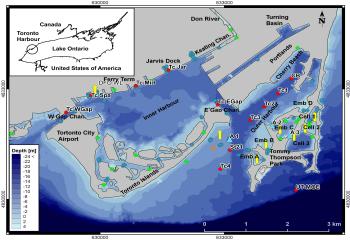
The harbour has three distinct zones with different hydrodynamic characteristics, namely the Outer Harbour, the Inner Harbour, and thirdly the Tommy Thompson Park area and the channels inside the Toronto Islands.
The Outer Harbour is connected directly to Lake Ontario through a wide opening and it is characterized by strong bathymetric slopes on the northern shore due to the presence of the navigation channel (10 m depth). The bottom is dominated by bedrock closer to the underwater Toronto escarpment but develops into mud substrate toward the head of the embayment.
The second zone, the Inner Harbour, contains the commercial harbour and is characterized by a quasi-uniform depth (10 m), with vertical walls on the northern shore and milder bathymetric slopes along the Toronto Islands. The connection from the Inner Harbour to the Outer Harbour is the 10 m deep Eastern Gap channel. To the west, the Inner Harbour is connected to Lake Ontario’s Humber Bay through the 10 m deep Western Gap channel. The composition of the bottom varies from bedrock near the Western Gap, clay and sand in the middle of the Inner Harbour and silty mud closer to the Don River mouth to the east, which is the major tributary that flows into the harbour. Based upon measurements made in 1977, Haffner et al. (1982) estimated the mean daily water bi-directional water exchange rate between Lake Ontario and Toronto Harbour to be 8.4 million m3day -1 (97 m3s-1), which for the inner part of the Harbour (the volume of which is approximately 40 x 106 m3 ) results in a residence time of approximately 5 days. Less than 8% of the total volume flux is driven from inflows from sources discharging into the harbour, such as the Don River (Haffner et al, 1982; Dewey, 2012), which has an average flow under 4 m3s-1.
The third zone comprises the shallower artificial embayments of Tommy Thompson Park (formerly known as the Leslie Street Spit) and the channels inside the Toronto Islands. This zone is sheltered from lake water intrusions and is characterized by slower currents and finer sand and mud substrates. A further noteworthy feature of the entire Harbour is in the proximity of very deep water in Lake Ontario. Immediately outside the 10-12 m deep Outer Harbour there is a steep under-water escarpment that drops off to 75 m depth within 600 m of the end of Tommy Thompson Park, making the Harbour especially sensitive to upwelling hypolimnetic waters from Lake Ontario.
More information is in this slideshow.
Copyright © Bogdan Hlevca All Rights Reserved